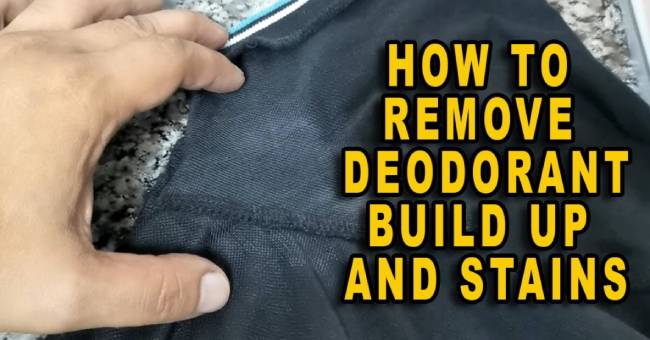Begone, white smudges and stains! These tips will help you remove pesky deodorant residue from your shirts-and prevent them from getting damaged.
Stains are an unfortunate fact of life. Fortunately, you won’t need to deal with stains of all kinds very often, such as blood stains and red wine stains. The same cannot be said for deodorant stains, which occur frequently. As a result. The present. Every time you put on a dark shirt, you stretch it as far down as you can to try to avoid your armpits, only to find –womp womp –white marks everywhere. You’re still likely to get that white deodorant residue near your armpits, which builds up over time and ultimately damages your shirts, even if you manage to avoid it. There is no need to grin and bear it or toss those items. There is no need to worry about deodorant stains on shirts if you know how to remove them.
What can you do to prevent this from happening? Take care of your clothes regularly instead of waiting until there’s a problem. Don’t worry: Even if you’re already noticing that white buildup, it’s not too late. Make sure you don’t end up with a permanent stain on your clothing by reaching for one of the best stain removers on the market. Some of the best stain fighters for deodorant stains are common household items, and the same applies to sweat stains.
Here are a few things we need to note before we get started: These strategies work best on cotton and poly-blend fabrics. It’s usually best to leave delicate fabrics such as silk, satin, or wool to the professionals and take them to a dry cleaner. In addition, for all the options below, soak the fabric in the warmest water permissible according to the care label. To combat deodorant stains, here are the most effective stain removers.
Table of Contents
How to Get Deodorant Stains Out of Shirts?
1. Vinegar
The best way to remove deodorant stains from shirts is with white vinegar. “Soaking your T-shirt in white vinegar can help lift stains and remove any lingering odors,” says Jennie Varney, brand manager for Molly Maid, a Neighborly brand. After soaking it for an hour, lightly agitate the area with a brush. You can also use vinegar to remove coffee stains from clothing after a regular laundry cycle.
2. Baking soda
Stains can be removed with this powder. Varney recommends mixing baking soda with water to form a paste before washing with hot water to gently agitate the stain. Depending on the severity of the stain, apply the paste to the stain, let it sit for anywhere from 20 minutes to overnight, then wash it as you normally would.
3. Lemon juice
According to Sean Busch, CEO and co-founder of Puracy, the acidity in this liquid can help break down the deodorant’s thickness. Most fabrics can also be washed with it. Varney recommends using lemon juice and water as a spot treatment, letting it sit on the stain for an hour before washing. Additionally, lemon is one of the secret ingredients you should add to your laundry regardless of whether it is stained or not.
4. Aspirin
Make a paste by crushing up some aspirin into a powder. Adding a bit of water can help treat white clothing, says Varney. Depending on how severe the stain is, let it sit for 20 minutes to an hour. It’s similar to baking soda in its effectiveness.
5. Hydrogen peroxide
It is really effective, but hydrogen peroxide could discolor your clothing, so experts recommend using it only on whites. Varney recommends soaking white garments in hydrogen peroxide and water before washing. If you want to test it on colored clothing, first test it on a small, not-visible spot to see if it causes any damage. Avoid using it on delicate fabrics like silk, satin, and wool.
6. Store-bought stain remover
Deodorant residue can be removed with classic stain removers. Busch recommends treating it with a stain remover, especially one that’s designed to remove all stains and residues, including white deodorant stains. Let it sit for 15 minutes, then throw it into your regular laundry with the rest of the clothes. Spray a stain remover on the clothing after your day, and that’s it. Don’t rub it in. The Laundress’ Stain Solution and Puracy’s Natural Stain Remover are both effective options.
7. Transfer the deodorant stain
What is the idea here? Before washing, lift the stain with another item. Varney says this disperses the density of the buildup. “Rub a clean cotton sock, shirt, or nylon stocking over the stain, then wash the items as usual.”
With deodorant stains, you have a little more breathing room than with other stains. The same is not true when dealing with grease, which is why you should bookmark this article on how to remove oil stains from clothes. When it comes to that one, time is of the essence!
How to get fresh deodorant marks out of clothing
In addition to knowing how to prevent and remove deodorant stains, what about those fresh white marks that get all over your shirt when you’re getting dressed? So you don’t need to change your outfit, follow these two steps to remove the stain on the spot.
1. Steam it
Don’t scrub the stain with a wet towel, which will only make the color run, says Onkar Bali of Bally’s Cleaners in Palm Desert, California. Steam the area instead to lightly moisturize it. It will loosen both the fabric and the deodorant, making it easier to remove.”
In the event that you do not own a steamer, remember that many irons have steaming capabilities. As an alternative, you can hang the shirt in your bathroom while taking a shower.
2. Rub it
Following the steaming process, there are a few ways to remove the stain manually. The first thing you need to do is scrub it with the right material. If you have a pair of balled-up pantyhose, you can use them to remove deodorant stains. Alternatively, you can use a new dryer sheet if you don’t have pantyhose. You don’t have either of those at home? You can use the stretchy, foam rubber strip you’ll find on dry cleaner hangers instead. You can also invest in a Miss Oops Rescue Sponge if you wear a lot of black. Deodorant and other powder-based stains are instantly removed, especially on darker-colored garments.
Once you’ve found the right dry, textured material to work with, you can begin. Rub the stain gently with the tool of your choice in circular motions. Fresher stains will lift faster, while older stains will take longer and require more effort to remove. You’ll gradually notice the white stain fading either way. You’ll want to avoid rubbing mustard, turmeric, or chocolate stains from clothing or other items when trying to remove deodorant stains. Those stains can become even more embedded in fabrics if they are rubbed.
What causes deodorant stains on clothing, anyway?
As Varney points out, deodorant easily transfers from our skin to our clothing, especially when wearing tight-fitting clothing. In addition, deodorants with antiperspirant, which is usually an aluminum-based compound, will stain your clothing over time as they react with sweat, resulting in yellowish stains. Even though gel and clear stick deodorant stains may not show up right away, they leave residue as well.
Is deodorant bad for your clothing?
Deodorant is made for skin, not clothing, and it can cause havoc on your clothes over time. “It’s designed to sit on your skin and slowly evaporate,” explains Busch. This is why deodorant doesn’t last for weeks on end, but is designed to last between 12 and 24 hours. You can start to break down the fibers of your shirt if you use too much deodorant and don’t treat it each time you wear it. Over time, some degradation occurs, which can discolor the material and thin it out.
Best deodorants that don’t stain clothes
It might be worth considering using a deodorant that leaves less or no residue if you’re tired of getting deodorant stains out of your shirts every day. Since glycol or glycerin-based deodorants are clear and translucent, they are less likely to stain your clothes, says Busch.
Additionally, antiperspirants and deodorants have very different effects on these stains. Varney says antiperspirants usually contain aluminum, which reacts with sweat and causes yellow stains in shirts’ underarms. “Aluminum salts can also embed themselves in our clothing, which can cause irreversible stains that are hard to remove from fabric.” If you use a deodorant without antiperspirant, you shouldn’t have this problem.
Deodorant options that won’t leave stains on shirts: Puracy Natural Deodorant, which is unscented and nontoxic; Kopari Aluminum-Free Coconut Deodorant, which is paraben-free and aluminum-free; and Native Deodorant, which is both.
Nonetheless, if you still end up with some marks on your clothing, make sure you treat them as soon as possible. Varney reminds us that the sooner we wash the item, the less likely the stain is to set. See how to remove makeup stains and nail polish stains from clothing for more toiletry mishaps.

